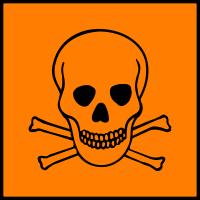|
Compostion
|
methylene chloride, ≤5% (solvent)
|
|
Concentration
|
13.4 M
|
|
Contains
|
≤15% ethanol and acetic acid (Packaged based on azoxymethane.)
|
|
Linear Formula
|
CH3N=N(→O)CH3
|
|
Purity
|
≥90% (GC)
|
|
Quality
|
Practical grade
|
|
Boiling Point
|
97-99 °C(lit.)
|
|
Density
|
0.991 g/mL at 25 °C(lit.)
|
|
Flash Point
|
24 °C
|
|
Flash Point
|
75.2 °F
|
|
GHS Pictograms
|

|
|
GHS Pictograms
|

|
|
GHS Pictograms
|

|
|
GHS Signal Word
|
Danger
|
|
GHS Hazard statements
|
H226-H300-H315-H319-H350
|
|
European Hazard Symbols
|
 Toxic (T) Toxic (T)
|
|
MSDS Link
|
Download
|
|
Personal Protective Equipment
|
Faceshields, full-face respirator (US), Gloves, Goggles, multi-purpose combination respirator cartridge (US), type ABEK (EN14387) respirator filter
|
|
GHS Precautionary statements
|
P201-P264-P301 + P310-P305 + P351 + P338-P308 + P313
|
|
RID/ADR
|
UN 1992 3/PG 3
|
|
Risk Statements
|
45-46-10-25-36/38
|
|
Safety Statements
|
53-26-45
|
|
Storage Temperature
|
-20°C
|
|
Hazard Class
|
3
|
|
UN Number
|
1992
|
|
Packing Group
|
3
|
|
German water hazard class
|
3
|